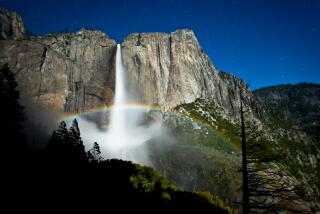It is Ansel Adams’ single most popular picture. And no one, not even the photographer, was sure when it was made. Until now. : ‘Moonrise’ Mystery
- Share via
HERNANDEZ, N.M. — Late one afternoon, after a frustrating day spent trying to photograph a cottonwood stump along the Chama River, Ansel Adams was driving back to Santa Fe when he noticed the moon rising over the Sangre de Cristo Mountains.
Pulling his station wagon off the road, Adams unloaded his 8-by-10 view camera and hastily calculated the proper exposure. From over his shoulder, the setting sun lit the snowcapped peaks and glinted off the white crosses of a cemetery in the foreground.
The moment he snapped the shutter, Adams knew he had captured something special. Just to be safe, though, he prepared to make a duplicate negative, but the sunlight left the crosses before he could do so.
“I was a few seconds too late!” Adams recalled in his 1983 book, “Examples: The Making of 40 Photographs.”
Adams’ instincts were unerring: The haunting “Moonrise, Hernandez, New Mexico,” with its ghostly moon hanging over an old adobe church and graveyard, became his most popular single image. But until earlier this year, no one knew exactly when the classic photograph had been made because Adams, known for his meticulous composition and exposure, neglected to record the date of the negative--as was his habit.
No one knew, that is, until Dennis di Cicco.
And after 10 years of checking and double-checking, Di Cicco reached his answer: 4:49:20 p.m. Mountain Standard Time on Nov. 1, 1941.
Di Cicco, whose findings are in the November Sky & Telescope--coincidentally the magazine’s 50th anniversary issue--says his results are accurate to within less than one minute.
“When I got the answer, finally,” says Di Cicco, amateur astronomer and associate editor of Sky & Telescope, “I was rather delighted by the whole thing.”
Serious attempts to date “Moonrise” began in 1980 with Santa Fe art historian Beaumont Newhall, a longtime friend and collaborator of Adams.
“I would plague him by asking him, ‘When did you make that photograph, Ansel?’ ” recalls Newhall, whose legendary photographic exhibitions at New York’s Museum of Modern Art in the 1930s helped establish photography as a legitimate art form.
“I had the thought that perhaps one could tell the date by the position of the moon in relationship to the ground,” Newhall says.
He turned to David Elmore, a solar physicist with the High Altitude Observatory in Boulder, Colo., little realizing that his scholarly query had the makings of a scientific detective story.
Elmore, in fact, came up with a calculation that had been accepted by everyone--including Adams--until Di Cicco came along.
Elmore set out to determine the moon’s altitude above the horizon and its azimuth (the angle from true north) as they appear in the photo. His tools included a topographic map to plot geographic coordinates. He also used a surveyor’s transit to make field measurements of the azimuths of several peaks in the photo.
Sitting at his computer, Elmore placed a transparency of the photograph over the screen and used his cursor to trace the outlines of the moon, mountains and village buildings. With help from Newhall, who said the photo had been taken during the autumn between 1941 and 1944, Elmore deduced there were 36 dates on which the moon could have been in about the position and phase shown in the photo.
Next, Elmore plotted the moon’s position for each of those dates onto his screen, looking for the one that most closely matched the outline he had traced from the photograph. Finally, he narrowed his list to one date and time: 4:03 p.m. on Oct. 31, 1941.
Adams, who died in 1984 at 82, took a personal interest in Elmore’s results, sending him a “Moonrise” postcard with a typed message that read in part: “Yippee.” Adams mentioned Elmore favorably in “Examples” and in his posthumously published autobiography.
There was only one problem with Elmore’s ingenious effort. It was wrong.
Unknown to him, his computer screen had distorted the ratio of height to width of the tracing, putting the moon in the wrong spot in the sky.
“That’s an inexcusable error,” Elmore says. Worse, he says, “I had the coordinates of Hernandez wrong, so when I computed the azimuths of the mountains, they were wrong.”
Elmore learned of his error last month when he was contacted by Di Cicco, who had pursued the question since seeing a report on Elmore’s study in the January, 1981, issue of American Photographer.
“I was impressed,” Elmore says. “I thought he’d done really good work.”
Di Cicco remembers being fascinated by Elmore’s quest from the moment he read about it.
“I was sitting there saying, ‘That’s neat,’ ” Di Cicco says. “I decided to plug Elmore’s data into my computer program, and I got the wrong results. Little did I know it would take 10 years to get the date.”
Using Elmore’s results, Di Cicco found that the moon should have been about 4 degrees above the horizon. But it was obvious from the photograph that it was higher. Puzzled, Di Cicco started fiddling with Elmore’s data.
Di Cicco traveled to northern New Mexico in 1984 and 1985 to establish where Adams had stood when he took the photograph and to take his own measurements. He concluded that Adams had been at the edge of an old roadbed, about 50 feet west of the spot on the modern highway that Elmore had identified.
After the second visit, “it was clear to me that on the day that Elmore picked, the moon was a long way from where it appears in the photo,” Di Cicco says.
He reran his own calculations and, using some circumstantial evidence, decided that Nov. 1, 1941, was probably right.
Di Cicco did not pursue the matter until earlier this year, when, on assignment in New Mexico, he made a side trip to Hernandez. Taking up Adams’ position, he shot a picture of a star-filled night sky. When he returned to his Boston-area home, he projected a slide of the stars over an image of “Moonrise.” Because he knew exactly when he took his picture, the stars’ precise positions could be calculated.
“I could plot Adams’ moon centered in my star field,” Di Cicco explains. “Once I had that, with literally 15 minutes at the computer, I had the answer.”
The fruits of Di Cicco’s minor obsession would probably be greeted with some indifference in Hernandez, an unincorporated community of several hundred people.
Fifty years after Adams’ brief visit, what was once an isolated mountain farming village has become little more than a suburb of bustling Espanola, six miles to the south. The gravel road Adams followed has turned into a heavily traveled U.S. highway, and scores of newer houses and ubiquitous mobile homes dot the area.
From time to time, picture-taking tourists stop on the highway and try to replicate “Moonrise,” but the view has changed.
The 140-year-old San Jose del Chama church, which stands in the left foreground of the photograph, has been used only occasionally since a replacement was built in 1972. A bell tower and pitched corrugated metal roof were added in the 1950s. The cemetery is choked with weeds, although families still leave flowers by some of the crosses and headstones. Chinese elms obscure many of the buildings and a county highway maintenance yard sits next to the church.
Old-timers remember the Hernandez of the photograph.
Orlando Ortega, who was born in an adobe house down the road from the village church, recalls that when he was a child in the 1930s and 1940s, it was so quiet he could hear the church bells from neighboring San Juan Pueblo, across the Chama River.
In those days, village residents grew their own corn, chili peppers and wheat and brought their crops to market in horse-drawn wagons, he says. There was no electricity, so food was stored in the ground and homes were lit with kerosene lamps or candles.
The 58-year-old Ortega, who keeps a framed print of “Moonrise” on his wall, can pick out a few buildings that are still standing. In the old days, he says, people had respect for one another and for themselves.
“It’s changed a lot,” Ortega says. “For the worse.”
More to Read
The biggest entertainment stories
Get our big stories about Hollywood, film, television, music, arts, culture and more right in your inbox as soon as they publish.
You may occasionally receive promotional content from the Los Angeles Times.










